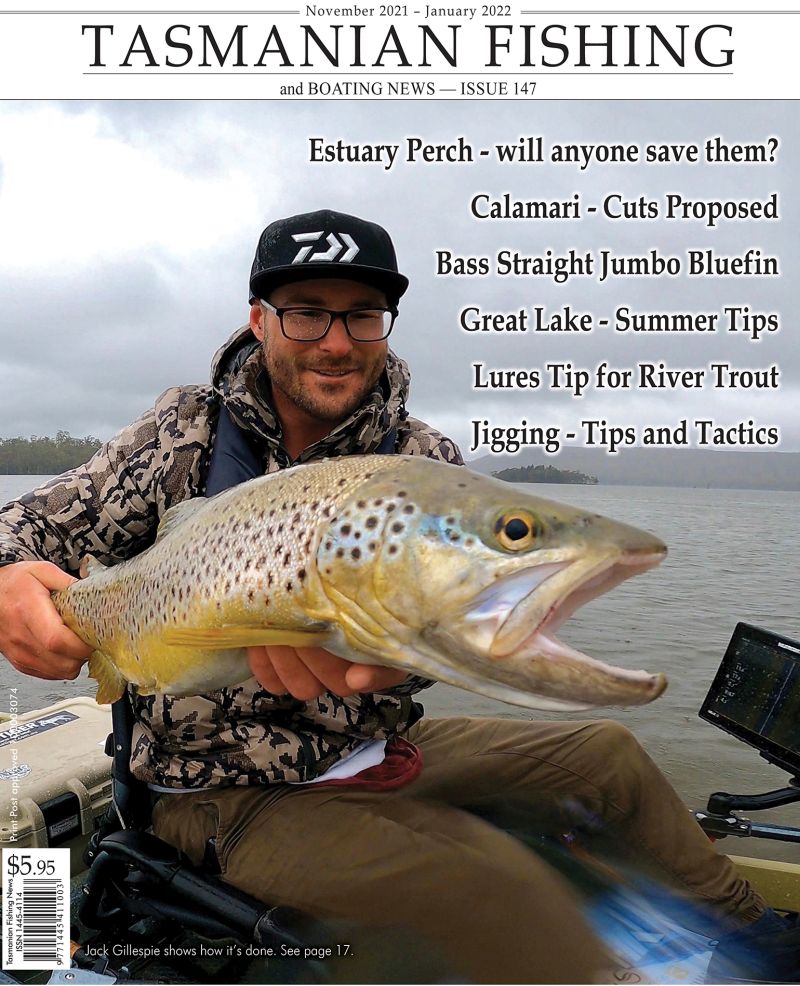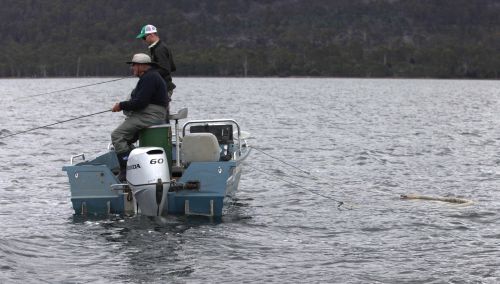From the Archives ...
Sea run trout tactics – Craig Vertigan
Sea run trout tactics – Craig Vertigan
During the trout off-season I tend to spend a bit of time chasing bream, to continue getting a fishing fix, and spend time tying flies and dreaming about the trout season to come. It’s a time to spend doing tackle maintenance, stocking up on lures and dreaming up new challenges and goals for the trout season ahead. When the new season comes around I usually spend the first few months targeting sea runners. Sea run trout are simply brown trout that spend much of there lives out to sea and come in to the estuaries for spawning and to feed on whitebait and the other small endemic fishes that spawn in late winter through spring. Mixed in with the silvery sea runners you can also expect to catch resident fish that have the typical dark colours of a normal brown trout as well as atlantic salmon in some of our estuaries that are located near salmon farm pens. Living in Hobart it is quick and easy to do a trip on the Huon or Derwent and is a more comfortable proposition compared to a trip up to the highlands with snow and freezing winds to contend with.
Read more ...Please check all relevant authorities before fishing - www.ifs.tas.gov.au and dpipwe.tas.gov.au . Don't forget issuu.com/stevenspublishing for years of back issues !
North West Snapper
During the Duck Bay recovery story in the last issue, we questioned the fact of the possibility of catching Snapper. It seems we are seeing an ever-increasing number of species being landed in the area, but snapper were few and far between. Sure, there had been the occasional one caught, but it was uncommon.
- Category: North West Coast
- Hits: 7247
Australian Salmon, Winter Estuary Excitement.
If there is one fish species that can help ease the winter blues, it would have to be the impressive Australian salmon. Locally known as either the cocky salmon or black back salmon, these great sport fish often remain in all the major estuary systems till the first big floods, and if the last few years are any indication, that means July or August. It doesn't matter how you plan to tackle salmon, with either bait, lure or fly, they are ready biters, sensational fighters, as well as being an acceptable, if not first class table fish.
- Category: Saltwater and Estuary Fishing
- Hits: 12532
Catching Big Game Fish
If you want to catch the big fish then you will need to start by specifically targeting the big fish. As with most forms of fishing, what ever the species is that you want to catch, it will need to be explicitly targeted. Gear, lures or baits, water temp and location all play an important role in the type of game fish you can encounter and the success that you may or may not have. Couple this with the prevailing weather conditions and you soon realise that there is more to it than just throwing a lure out and trolling around the ocean all day.
- Category: Tuna Fishing and other Game Fishing
- Hits: 7298
SUPER SEA MULLET
The New Estuary Gamefish!
Sea Mullet. Most people would think of the yellow eye mullet that is prolific in Tasmanian estuaries. The sea mullet is a different type of mullet that grows much bigger that the common yellow eye mullet, and is extremely powerful when hooked. In fact, their fighting capabilities are astounding, as I found. They are very "dirty" fighters, going for any snags they can find. Sea mullet are very hard to catch because they are reluctant to take a bait.
- Category: Saltwater and Estuary Fishing
- Hits: 12616
Autumn Tips and Tricks
It can be the best of times; it can be the worst of times. Autumn, that is. The last months of the trout fishing season can be as good as any other, particularly if the beetles and jassids make an appearance in numbers, or if the mayfly dribble on into the gloaming of the season. However if the winter rains come early, and the snow and sleet crash the party, it can be incredibly miserable as well. But perhaps the best saving grace for this time of year is that the water is still warm enough to get things moving insect wise, the trout still remember how to look up for food, and the bigger trout are getting very aggressive prior to spawning. By mixing up a variety of techniques over the days fishing, success can be almost assured. Almost!
- Category: Trout Fishing
- Hits: 7901
Preparing For The Coming Game Fishing Season
By the time this edition of Tasmanian Fishing and Boating News goes to press the coming game fishing season will be almost upon us. At the time of writing this article the 18-19 degree water currents that we all wait for were level with the northern tip of Flinders Island, an almost certain indication that the game season will get under way a lot earlier than would normally be expected.
Time to pull out the tackle and brush off the cobwebs in preparation for what promises to be an excellent season.
- Category: Tuna Fishing and other Game Fishing
- Hits: 5313
Dry Flys With Attitude
If there has been one single revolution in Tasmanian fly fishing in the last three years, it would have to be the use of the English style reservoir dry flies. Popularly known as the pommy" dries, these bright little numbers have taken loch style fishing in the Tasmanian entral highlands by storm. There has been quite a bit written about them lately, and as he technique is developed even further, no doubt a few more thousand words will be pawned in fly fishing publications.
- Category: Fly Fishing
- Hits: 7366
Ask The Guru
GURU
" An acknowledged expert, a teacher"
In this issue we begin a new column for readers to ask the questions they
were always too afraid to ask. Tasmanian Fishing and Boating News has
assembled the best fishing brains in the business to answer your questions.
To start off we have put together a few sample questions, to give readers an
idea of what is involved.
- Category: Fly Fishing
- Hits: 5852
Blue Peaks - Bob Cooper
Here Bob Cooper lets us in on what the devil he gets up to in the Blue Peaks region of the Central Plateau. Bob is well known in angling circles for his capacity to walk great distances whilst claiming to be fishing. In his own unique style, Bob gives us the run down on a magnificent part of Tasmania.
- Category: Tuna Fishing and other Game Fishing
- Hits: 7727
Hot Spots
There has been some terrific fishing on the far north west of Tasmania - especially around Smithton and Stanley.
The whole of the northern coast has been fishing well for larger than usual flathead as they move in to shore with warmer water.
- Category: Saltwater and Estuary Fishing
- Hits: 9960
Subcategories
Current TFBN
Click above for current issue content. The current issue of TFBN is extensive and topical. In Tackle Stores, Newsagents and by subscription.
Delivered to your door for $48 for 2 years (8 issues). To subscribe, send Mike $48 via www.paypal.com.au . (Basic instructions are here) The email is at Contact Us. Your address will be included from PayPal.
Or phone Mike with your c/c handy on 0418129949
Please ensure your details are correct, for Mike to organise delivery.
TFBN Newsletter Sign up Form
Why not submit an article ?
When you have finished for the day, why not have a brag about the ones that didn't get away! Send Mike an article on your fishing (Click here for contact details), and we'll get it published here. Have fun fishing - tasfish.com
Category Descriptions
Here is a list of all of the Article Categories. The number in Brackets, eg (13) is the number of articles. Click on Derwent River and all articles relating to the Derwent will be displayed in the central area.
Articles by Category
-
Rivers (3)
-
Saltwater and Estuary Fishing (149)
-
Kayak Fishing (34)
-
Lakes (1)
-
Great Lake (62)
-
Lake Leake (52)
-
Woods Lake (16)
-
Lake Augusta (11)
-
Huntsman Lake (13)
-
Lake Pedder and Gordon (10)
-
Lake Dulverton (5)
-
Lake Crescent (6)
-
Tooms Lake (10)
-
Lake Mackintosh (2)
-
Lake Barrington (5)
-
Little Lake (8)
-
Meadowbank Lake (5)
-
Lake King William (7)
-
Lake St Clair (2)
-
Western Lakes (12)
-
Arthurs Lake (35)
-
Lake Echo (7)
-
Four Springs (54)
-
Lake Sorell (7)
-
Lake Burbury (6)
-
Other Lakes (57)
-
Brushy Lagoon (18)
-
Little Pine Lagoon (5)
-
Penstock Lagoon (16)
-
Brumbys Creek (7)
-
-
Events (48)
-
Estuary Fishing (0)
-
Coastal Catches (46)
-
Super Trawler (46)
-
IFS, DPIPWE, MAST and Peak Bodies (435)
-
Commercial Interests (98)
-
Other (24)
-
TFBN Back Issues (8)
-
Fly Fishing (67)
-
Trout Fishing (252)
-
Meteorology and Weather (8)
-
Jan’s Flies (50)
-
Tuna Fishing and other Game Fishing (86)
-
Cooking Fish (19)
-
Fishing Information (1)
-
Fishing Books (8)
-
Videos (5)
-
Tackle, Boats and other Equipment (146)
-
World Fly Fishing Championship 2019 (2)
Popular Tags
windyty.com
Visit https://www.windyty.com/
Rubicon Web and Technology Training
Hello everyone, I thought it would be a good time to introduce myself.
My name is Stephen Smith and I have been managing the website tasfish.com since May 2009.
It has been an epic journey of learning and discovery and I am indebted to Mike Stevens for his help, support and patience.
I am developing a new venture Rubicon Web and Technology Training ( www.rwtt.com.au ). The focus is two part, to develop websites for individuals and small business and to train people to effectively use technology in their everyday lives.
Please contact me via www.rwtt.com.au/contact-me/ for further information - Stephen Smith.
From the Archives ... (last chance)
Tiny creeks and sea run trout - Christopher Bassano
Presented from Issue 105, August 2013
Christopher Bassano fishes over 250 days a year. This interview was recorded just before he headed off to fish for Australia in the World Fly Fishing Championships in Norway 14-17 August 2013.
I live on a small stream and at the start of the season I like to go off on a bit of a discovery mission and fish the headwaters of the creeks and rivers I feel an affinity with.
These small rivers include the St Pats, Meander, Forester, Little Forester and others. The further up you go on these rivers the clearer and lower the levels. They are often less affected by the rain and runoff and you get some good opportunities. Get as close to the source as you can and you will find some good dry fly fishing. Don’t limit yourself to those I have mentioned. Most headwaters will hold trout.
Read more ...


